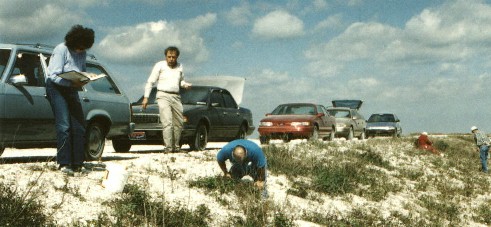| Big Sugar, The Glades, And Fossils |
| By Bill Frank |
 South Florida's big sugar industry and its detrimental effects on the Everglades has been a recurring topic in both the print and broadcast media for many months. Eight environmentally-conscious members of the Jacksonville Shell Club (JSC) (Bill & Betsy Lyerly, Bill Frank, Mary Reynolds, Betty Hunter, George Hapsis (Tallahassee), Jack Gebert, and Mike Noble, therefore decided to conduct an fact-finding mission to the area over the President's Day Weekend (Feb. 17-19). Having no experience with the area, the club enlisted the help of Phyllis Diegel, President and Editor of the Palm Beach County Shell Club and her fellow club members to provide guidance. Following a six and a half hour drive from Jacksonville, the aforementioned JSC Members met up with Helen Kwiat (Central Florida Shell Club), Allan Gettleman (Merritt Island), and Palm Beach County Members at the trip Hqs. (Travelers Motor Lodge) to begin the quest. After a ten minute drive, the group arrived at the spoil piles (late Pleistocene) at the North New River Canal along Route 27 near the town of South Bay, Palm Beach County. Fossils were everywhere and plentiful. You just had to extract them from the 15 foot high wall of material with a composition similar to hardened concrete. Mike Noble, well known for his ability to move prodigious amounts of material in the Panhandle scallop dumps, was more aggressive than most, attacking the wall with a pick-axe. Amazingly, most of the olive shells retained virtually all of their original color and gloss and looked like they were fresh dead. Following several hours of chipping and digging, a majority of the group headed off in search of a suitable facility for the evening repast. This goal proved elusive, and ultimately a 26 mile drive to Sonny's BBQ in Clewiston was necessary to find seating for our group of 14. The next morning, it was back out to the same locale for more excavating. Escalating temperatures, in conjunction with the choking clouds of dust from the speeding passing cane trucks, provided sufficient impetus for the group to investigate a new location ?nearby?. With Phyllis in the lead, the group was off to a location along the Miami Canal (Pliocene\Pleistocene). After traversing some "interesting" roads through the sugar cane fields, a single car width wide with precipitous canals on both sides, the group reached Nirvana. Here, exposed and ripe for the picking, were literally miles of fossils, a fauna with diversity reminiscent of the APAC Fossil Pit in Sarasota (now closed). A few hours later, with "buckets-a-brimming," it was time to go back over the "interesting roads" to Belle Glade for an early but lengthy evening meal at Dino's Pizza. The next morning, three of the group (Betty, Mary, and Bill Frank) drove to Delray Beach to visit Tom Honker (well known specimen shell dealer) and his wife, Paula. Their hospitality was impressive. Following the visit, it was time to retrace Interstate 95 back to Jacksonville. It was a very educational, profitable, and enjoyable trip. Yes, Big Sugar is there with cane fields extending beyond the horizon, the aquifer replenishment canals from Lake Okeechobee are present, and little else - other than fossils from the so called "Loxahatchee Trough." It's worth the trip to just to see this remote and unique part of Florida; the fossils only give one a pretext for making the trip. Special thanks go to Phyllis Diegel for her time and efforts to make the trip a success, Carole Marshal for her assistance to Mike Noble when his car decided that it was time for some major parts' replacements, other members of the Palm Beach County Shell Club, and Tom and Paula Honker for their hospitality. See you on the next Everglades trip! No, we saw no snakes - but plenty of alligators.
|
|
Exposed fossils along the Miami Canal. Pictured are Phyllis Diegel (l.) and Allan Gettleman (r.). |
